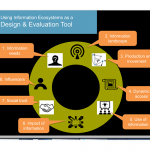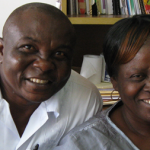mHealth Summit Offers Opportunity to Reflect on Online Communities
 I had the privilege of attending the sixth annual mHealth Summit – held last week at the Gaylord National Resort & Convention Center – and participating in several sessions on behalf of the Health Communication Capacity Collaborative (HC3). The mHealth Summit brings together technology vendors, non-profit organizations, universities and more each year to consider the challenges and progress made in the field of mHealth.
I had the privilege of attending the sixth annual mHealth Summit – held last week at the Gaylord National Resort & Convention Center – and participating in several sessions on behalf of the Health Communication Capacity Collaborative (HC3). The mHealth Summit brings together technology vendors, non-profit organizations, universities and more each year to consider the challenges and progress made in the field of mHealth.
HC3 presented at a variety of sessions and disseminated information on health communication tools and resources. Some topics discussed include blended communities of practice (CoPs), data collection tools, and monitoring and evaluation for social and behavior change communication (SBCC) interventions.
Making Connections for Sustainable ICTs
In a session entitled “Making Connections for Sustainable ICTs,” I presented Springboard for Health Communication and the experience HC3 had when launching this community for health communication practitioners. According to Etienne Wenger-Trayner, a CoP refers to any group of individuals who come together around a shared interest to cultivate learning and better their practice.
Springboard is designed to bridge a gap in the SBCC field by providing a space for health communication practitioners to connect with one another and to obtain the latest news and information from the field. Although it has more than 2,000 members, the launch of Springboard’s online platform has not gone without challenges. Some key questions for any CoP, particularly in the early stages, include:
- Structured or community directed? Should the CoP have a structured format or topic areas for discussion, or should the trajectory of the CoP be left up to the community?
- Virtual or face-to-face? How much of a community is defined by its virtual activities and interactions as opposed to its face-to-face interactions?
- How do we spur and maintain engagement? It is one thing to have registered users on the site, but how do we ensure participants are getting what they need out of the resource?
- When is it over? How do we know when a CoP has run its course and the participants no longer have a need for that particular community?
Panelists Steve Ollis, D-Tree International, and Dr. Mwendwa Mwenesi, mHealth Country Coordinator in Tanzania, spoke about their experience setting up a local CoP focused on mHealth. A general consensus reached during the panel was that blended CoPs have the potential for the greatest impact, meaning that including virtual and face-to-face elements in a CoP can lead to greater interactivity and engagement rather than only virtual or only face-to-face. The discussion concluded with a few key steps considered integral to setting up and maintaining a CoP.
- Know your audience: It is vital to understand who your target audience is, what their needs are, and what their accessibility to technology is as you set up a CoP.
- Have a goal but be flexible: Having a clear goal for your CoP will help guide the format and topic areas. However, if your audience’s needs change, then it is very important to have flexibility in the format and goal of your CoP to accommodate their needs.
- Evaluate: Monitor and evaluate the progress of your CoP after events and on a regular basis. These evaluations will help guide the next steps of your CoP.
SBCC mHealth Tools and Resources
mHealth interventions can help enhance SBCC campaigns in various ways. Technologies can help broaden the reach of the campaign and its messages, and technologies can help obtain and disseminate large amounts of data in a relatively short amount of time.
Several mHealth Summit sessions outlined the use of such tools, particularly looking at data collection and monitoring and evaluation (M&E). While many tools have been developed recently for these purposes, several sessions focused on how to choose the appropriate tools for particular campaigns. For example, if your audience is largely illiterate, then mobiles should only be used for voice messages or for videos instead of SMS. Or, if women do not have access to mobile phones, then mobile phones are probably not the best technology to use for women’s health or family planning messaging.
One M&E tool – LiST: The Lives Saved Tool –highlighted can model the outcomes of an entire intervention, parsing out how much of those outcomes were impacted by the technology itself. This can be a highly effective and impactful M&E tool for SBCC, as much of the time, the question is: how much of the health impact was actually due to my specific intervention?
Each year, the mHealth Summit brings together a highly motivated and innovative group of people to discuss mHealth gaps and progress. Keeping these important conversations going between summits can help improve our own campaigns and efforts in the field, and help increase the impact of SBCC to improve health outcomes.








Leave a Reply
Want to join the discussion?Feel free to contribute!